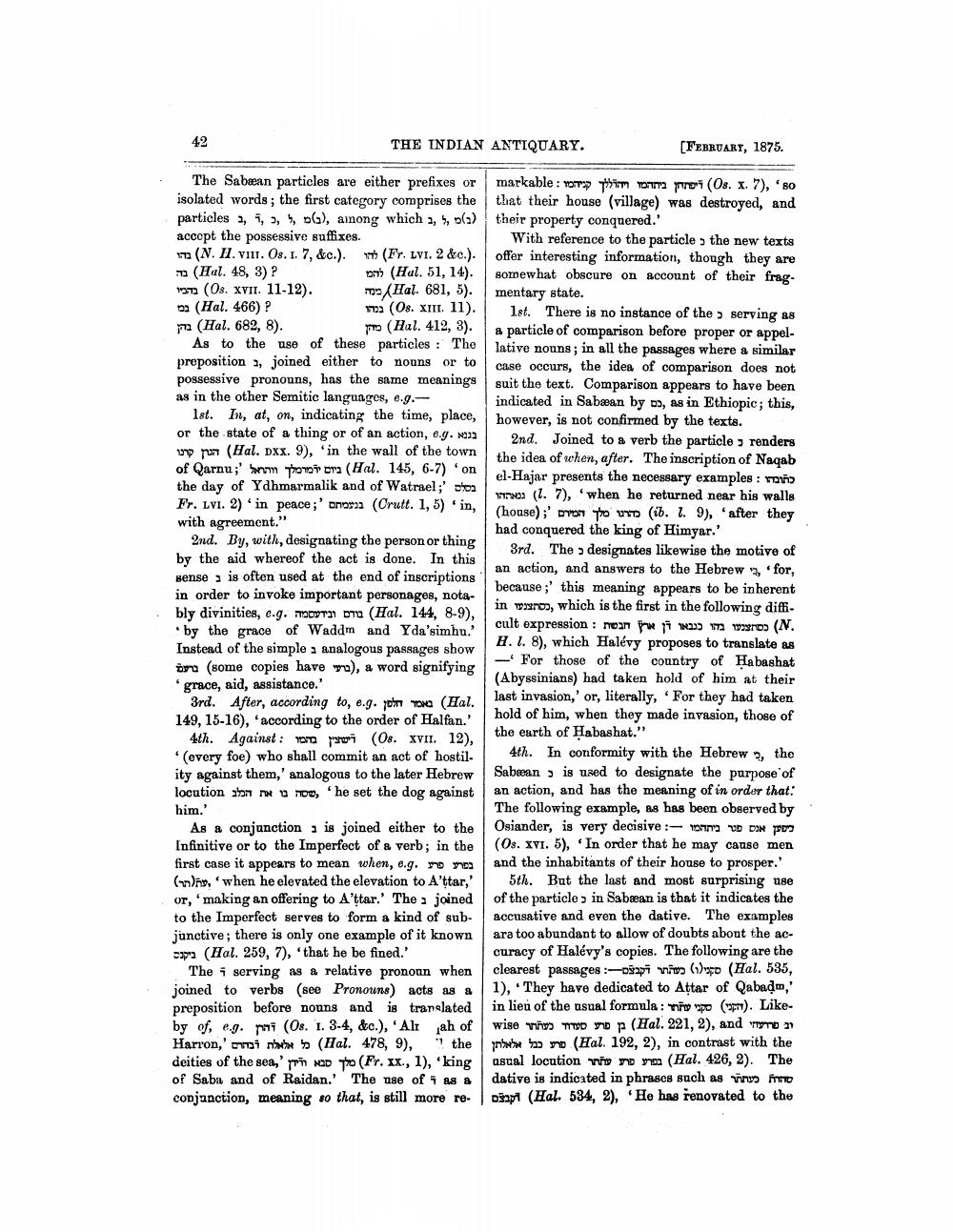________________
42
THE INDIAN ANTIQUARY.
The Sabean particles are either prefixes or isolated words; the first category comprises the particles 1,,,, ), among which 1, 5, (1) accept the possessive suffixes.
(N. HI. VIII. Os. I. 7, &c.). (Hal. 48, 3) ? 127 (08. XVII. 11-12). (Hal. 466) ?
(Hal. 682, 8).
(Hal. 681, 5). (08. XIII. 11). (Hal. 412, 3). As to the use of these particles: The preposition 1, joined either to nouns or to possessive pronouns, has the same meanings as in the other Semitic languages, e.g.
1st. In, at, on, indicating the time, place, or the state of a thing or of an action, e.g. up run (Hal. DXX. 9), 'in the wall of the town of Qarnu;' m poor (Hal. 145, 6-7) 'on the day of Ydhmarmalik and of Watrael;'
Fr. LVI. 2) in peace;' onor (Crutt. 1, 5) in, with agreement."
Th(Fr. LVI. 2 &c.).
him.'
.(14 ,51 .Hal) להם
2nd. By, with, designating the person or thing by the aid whereof the act is done. In this sense 1 is often used at the end of inscriptions in order to invoke important personages, notably divinities, c.g. т DT (Hal. 144, 8-9), by the grace of Waddm and Yda'simhu.' Instead of the simple a analogous passages show bra (some copies have wa), a word signifying grace, aid, assistance.'
3rd. After, according to, e.g. 1oo (Hal. 149, 15-16), according to the order of Halfan.' 4th. Against: (08. XVII. 12), '(every foe) who shall commit an act of hostility against them,' analogous to the later Hebrew
he set the dog against שטה בו את הכלב locution
As a conjunction 1 is joined either to the Infinitive or to the Imperfect of a verb; in the first case it appears to mean when, e.g. (n), when he elevated the elevation to A'ṭtar,' or, making an offering to A'ttar.' The joined to the Imperfect serves to form a kind of subjunctive; there is only one example of it known (Hal. 259, 7), 'that he be fined.'
The serving as a relative pronoun when joined to verbs (see Pronouns) acts as a preposition before nouns and is translated by of, eg. (08. 1. 3-4, &c.), 'Alr ah of Harron,' in (Hal. 478, 9), "the deities of the sea,' TND TO (Fr. xx., 1), 'king of Saba and of Raidan.' The use of as a conjunction, meaning so that, is still more re
[FEBRUARY, 1875.
markable: om op (08. x. 7), 'so that their house (village) was destroyed, and their property conquered.'
With reference to the particle the new texts offer interesting information, though they are somewhat obscure on account of their fragmentary state.
1st. There is no instance of the serving as a particle of comparison before proper or appellative nouns; in all the passages where a similar case occurs, the idea of comparison does not suit the text. Comparison appears to have been indicated in Sabean by oo, as in Ethiopic; this, however, is not confirmed by the texts.
2nd. Joined to a verb the particle renders the idea of when, after. The inscription of Naqab el-Hajar presents the necessary examples: ron
(1. 7), when he returned near his walls (house); an to D (ib. l. 9), after they had conquered the king of Himyar.'
3rd. The designates likewise the motive of because; this meaning appears to be inherent an action, and answers to the Hebrew ", 'for, in war, which is the first in the following diffi
.N) כסתצבעו בהו כנבאו דן ארץ חבשת :cult expression
H. l. 8), which Halévy proposes to translate as
For those of the country of Habashat (Abyssinians) had taken hold of him at their last invasion,' or, literally, 'For they had taken hold of him, when they made invasion, those of the earth of Habashat."
4th. In conformity with the Hebrew, the Sabean is used to designate the purpose of an action, and has the meaning of in order that: The following example, as has been observed by Osiander, is very decisive: DIN (Os. XVI. 5), In order that he may cause men and the inhabitants of their house to prosper.'
5th. But the last and most surprising use of the particle in Sabean is that it indicates the accusative and even the dative. The examples ara too abundant to allow of doubts about the accuracy of Halévy's copies. The following are the clearest passages-pin (1) (Hal. 535, 1), They have dedicated to Attar of Qabaḍm,' in lieu of the usual formula: (). Likewise op (Hal. 221, 2), and (Hal. 192, 2), in contrast with the usual locution (Hal. 426, 2). The dative is indicated in phrases such as Dip (Hal. 534, 2), 'He has renovated to the




